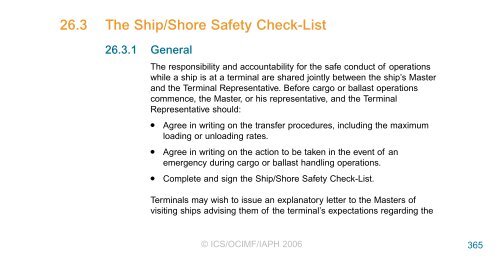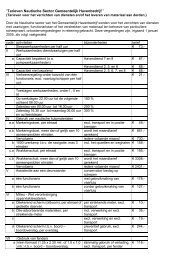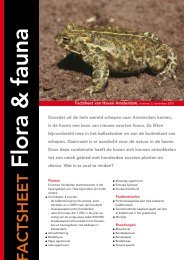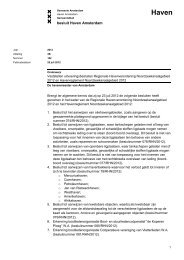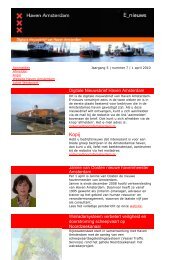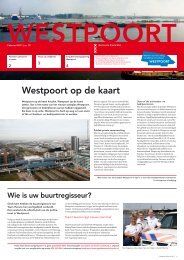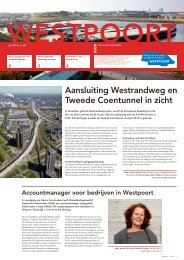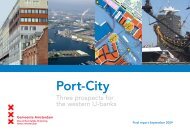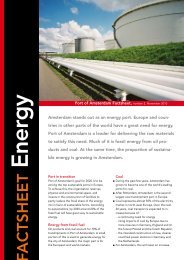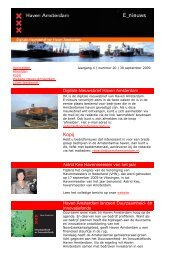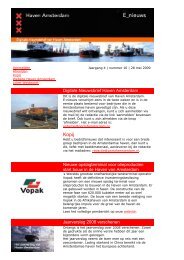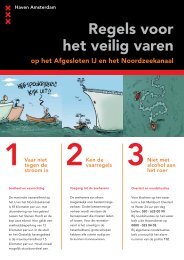26.3 The Ship/Shore Safety Check-List
26.3 The Ship/Shore Safety Check-List
26.3 The Ship/Shore Safety Check-List
Create successful ePaper yourself
Turn your PDF publications into a flip-book with our unique Google optimized e-Paper software.
<strong>26.3</strong> <strong>The</strong> <strong>Ship</strong>/<strong>Shore</strong> <strong>Safety</strong> <strong>Check</strong>-<strong>List</strong><br />
<strong>26.3</strong>.1 General<br />
<strong>The</strong> responsibility and accountability for the safe conduct of operations<br />
while a ship is at a terminal are shared jointly between the ship’s Master<br />
and the Terminal Representative. Before cargo or ballast operations<br />
commence, the Master, or his representative, and the Terminal<br />
Representative should:<br />
● Agree in writing on the transfer procedures, including the maximum<br />
loading or unloading rates.<br />
● Agree in writing on the action to be taken in the event of an<br />
emergency during cargo or ballast handling operations.<br />
● Complete and sign the <strong>Ship</strong>/<strong>Shore</strong> <strong>Safety</strong> <strong>Check</strong>-<strong>List</strong>.<br />
Terminals may wish to issue an explanatory letter to the Masters of<br />
visiting ships advising them of the terminal’s expectations regarding the<br />
© ICS/OCIMF/IAPH 2006<br />
365
366<br />
INTERNATIONAL SAFETY GUIDE FOR OIL TANKERS AND TERMINALS<br />
joint responsibility for the safe conduct of operations, and inviting the<br />
co-operation and understanding of the tanker’s personnel. An example<br />
of the text for such a letter is in Section <strong>26.3</strong>.4.<br />
While the <strong>Ship</strong>/<strong>Shore</strong> <strong>Safety</strong> <strong>Check</strong>-<strong>List</strong> is based upon cargo handling<br />
operations, it is recommended that the same practice is adopted when<br />
a tanker presents itself at a berth for tank cleaning.<br />
<strong>26.3</strong>.2 Guidelines for Use<br />
Guidelines for completing the <strong>Check</strong>-<strong>List</strong> and to assist in responding to<br />
each individual statement are included in Section 26.4. <strong>The</strong>y have been<br />
produced to assist berth operators and ships’ Masters in their joint use of<br />
the <strong>Ship</strong>/<strong>Shore</strong> <strong>Safety</strong> <strong>Check</strong>-<strong>List</strong>.<br />
<strong>The</strong> Master and all under his command should adhere strictly to these<br />
requirements throughout the ship’s stay alongside. <strong>The</strong> Terminal<br />
Representative and all shore personnel should do likewise. Each party will<br />
be committed to co-operate fully in the mutual interest of achieving safe<br />
and efficient operations.<br />
Responsibility and accountability for the statements within the <strong>Ship</strong>/<strong>Shore</strong><br />
<strong>Safety</strong> <strong>Check</strong>-<strong>List</strong> are assigned within the document. <strong>The</strong> acceptance of<br />
responsibility is confirmed by ticking or initialling the appropriate box and<br />
finally signing the declaration at the end of the <strong>Check</strong>-<strong>List</strong>. Once signed,<br />
the <strong>Check</strong>-<strong>List</strong> details the minimum basis for safe operations as agreed<br />
through the mutual exchange of critical information.<br />
Some of the <strong>Check</strong>-<strong>List</strong> statements are directed to considerations for<br />
which the ship has sole responsibility and accountability, some to<br />
considerations for which the terminal has sole responsibility and<br />
accountability, and there are others which assign joint responsibility and<br />
accountability. Shaded boxes are used to identify statements that<br />
generally would be applicable to only one party, although the ship or<br />
terminal may tick or initial such sections if they so wish.<br />
<strong>The</strong> assignment of responsibility and accountability does not mean that<br />
the other party is excluded from carrying out checks in order to confirm<br />
compliance. It is intended to ensure clear identification of the party<br />
responsible for initial and continued compliance throughout the ship’s stay<br />
at the terminal.<br />
<strong>The</strong> Responsible Officer should personally check all considerations lying<br />
within the responsibility of the tanker. Similarly, the Terminal<br />
Representative should personally check all considerations that are the<br />
terminal’s responsibility. In fulfilling these responsibilities, representatives<br />
should assure themselves that the standards of safety on both sides of<br />
the operation are fully acceptable. This can be achieved by means<br />
such as:<br />
● Confirming that a competent person has satisfactorily completed the<br />
<strong>Check</strong>-<strong>List</strong>.<br />
● Sighting appropriate records.<br />
● Joint inspection, where deemed appropriate.<br />
For mutual safety, before the start of operations, and from time to time<br />
thereafter, a Terminal Representative and, where appropriate, a<br />
Responsible Officer, should conduct an inspection of the ship to ensure<br />
© ICS/OCIMF/IAPH 2006
SAFETY MANAGEMENT<br />
that the ship is effectively managing its obligations, as accepted in the<br />
<strong>Ship</strong>/<strong>Shore</strong> <strong>Safety</strong> <strong>Check</strong>-<strong>List</strong>. Similar checks should be conducted<br />
ashore. Where basic safety requirements are found to be insufficient,<br />
either party may require that cargo and ballast operations are stopped<br />
until corrective action is implemented satisfactorily.<br />
<strong>26.3</strong>.2.1 Composition of the <strong>Check</strong>-<strong>List</strong><br />
<strong>The</strong> <strong>Ship</strong>/<strong>Shore</strong> <strong>Safety</strong> <strong>Check</strong>-<strong>List</strong> comprises four parts, the first<br />
two of which (Parts ‘A’ and ‘B’) address the transfer of Bulk<br />
Liquids. <strong>The</strong>se are applicable to all operations. Part ‘A’ identifies<br />
the required physical checks and Part ‘B’ identifies elements that<br />
are verified verbally.<br />
Part ‘C’ contains additional considerations relating to the transfer<br />
of Bulk Liquid Chemicals and Part ‘D’ contains those for Bulk<br />
Liquefied Gases.<br />
<strong>The</strong> safety of operations requires that all relevant statements are<br />
considered and the associated responsibility and accountability for<br />
compliance are accepted, either jointly or singly. Where either<br />
party is not prepared to accept an assigned accountability, a<br />
comment must be made in the ‘Remarks’ column and due<br />
consideration should be given to assessing whether operations<br />
can proceed.<br />
Where a particular item is considered not to be applicable to the<br />
ship, the terminal or to the planned operation, a note to this effect<br />
should be entered in the ‘Remarks’ column.<br />
<strong>26.3</strong>.2.2 Coding of Items<br />
<strong>The</strong> presence of the letters ‘A’, ‘P’ or ‘R’ in the column entitled<br />
‘Code’ indicates the following:<br />
A (‘Agreement’). This indicates an agreement or procedure that<br />
should be identified in the ‘Remarks’ column of the <strong>Check</strong>-<strong>List</strong><br />
or communicated in some other mutually acceptable form.<br />
P (‘Permission’). In the case of a negative answer to the<br />
statements coded ‘P’, operations should not be conducted<br />
without the written permission from the appropriate authority.<br />
R (‘Re-check’). This indicates items to be re-checked at<br />
appropriate intervals, as agreed between both parties, at<br />
periods stated in the declaration.<br />
<strong>The</strong> joint declaration should not be signed until both parties have<br />
checked and accepted their assigned responsibilities and<br />
accountabilities.<br />
© ICS/OCIMF/IAPH 2006<br />
367
368<br />
INTERNATIONAL SAFETY GUIDE FOR OIL TANKERS AND TERMINALS<br />
<strong>26.3</strong>.3 <strong>The</strong> <strong>Ship</strong>/<strong>Shore</strong> <strong>Safety</strong> <strong>Check</strong>-<strong>List</strong><br />
<strong>Ship</strong>’s Name<br />
Berth<br />
Date of Arrival<br />
Part ‘A’ – Bulk Liquid General – Physical <strong>Check</strong>s<br />
Bulk Liquid – General <strong>Ship</strong> Terminal Code Remarks<br />
1. <strong>The</strong>re is safe access between the<br />
ship and shore.<br />
2. <strong>The</strong> ship is securely moored.<br />
3. <strong>The</strong> agreed ship/shore<br />
communication system is operative.<br />
4. Emergency towing-off pennants are<br />
correctly rigged and positioned.<br />
5. <strong>The</strong> ship’s fire hoses and fire-fighting<br />
equipment are positioned and ready<br />
for immediate use.<br />
6. <strong>The</strong> terminal’s fire-fighting<br />
equipment is positioned and ready<br />
for immediate use.<br />
7. <strong>The</strong> ship’s cargo and bunker hoses,<br />
pipelines and manifolds are in good<br />
condition, properly rigged and<br />
appropriate for the service intended.<br />
8. <strong>The</strong> terminal’s cargo and bunker<br />
hoses or arms are in good condition,<br />
properly rigged and appropriate for<br />
the service intended.<br />
9. <strong>The</strong> cargo transfer system is<br />
sufficiently isolated and drained to<br />
allow safe removal of blank flanges<br />
prior to connection.<br />
10. Scuppers and save-alls on board are<br />
effectively plugged and drip trays<br />
are in position and empty.<br />
11. Temporarily removed scupper plugs<br />
will be constantly monitored.<br />
12. <strong>Shore</strong> spill containment and sumps<br />
are correctly managed.<br />
13. <strong>The</strong> ship’s unused cargo and bunker<br />
connections are properly secured<br />
with blank flanges fully bolted.<br />
14. <strong>The</strong> terminal’s unused cargo and<br />
bunker connections are properly<br />
secured with blank flanges fully<br />
bolted.<br />
© ICS/OCIMF/IAPH 2006<br />
Port<br />
Time of Arrival<br />
R<br />
R<br />
A R<br />
R<br />
R<br />
R<br />
R<br />
R<br />
R<br />
System:<br />
Backup System:
SAFETY MANAGEMENT<br />
Bulk Liquid – General <strong>Ship</strong> Terminal Code Remarks<br />
15. All cargo, ballast and bunker tank<br />
lids are closed.<br />
16. Sea and overboard discharge valves,<br />
when not in use, are closed and<br />
visibly secured.<br />
17. All external doors, ports and<br />
windows in the accommodation,<br />
stores and machinery spaces are<br />
closed. Engine room vents may be<br />
open.<br />
18. <strong>The</strong> ship’s emergency fire control<br />
plans are located externally.<br />
© ICS/OCIMF/IAPH 2006<br />
R<br />
Location:<br />
If the ship is fitted, or is required to be fitted, with an inert gas system (IGS), the following<br />
points should be physically checked:<br />
Inert Gas System <strong>Ship</strong> Terminal Code Remarks<br />
19. Fixed IGS pressure and oxygen<br />
content recorders are working.<br />
20. All cargo tank atmospheres are at<br />
positive pressure with oxygen<br />
content of 8% or less by volume.<br />
Part ‘B’ – Bulk Liquid General – Verbal Verification<br />
R<br />
P R<br />
Bulk Liquid – General <strong>Ship</strong> Terminal Code Remarks<br />
21. <strong>The</strong> ship is ready to move under its<br />
own power.<br />
22. <strong>The</strong>re is an effective deck watch in<br />
attendance on board and adequate<br />
supervision of operations on the<br />
ship and in the terminal.<br />
23. <strong>The</strong>re are sufficient personnel on<br />
board and ashore to deal with an<br />
emergency.<br />
24. <strong>The</strong> procedures for cargo, bunker<br />
and ballast handling have been<br />
agreed.<br />
25. <strong>The</strong> emergency signal and shutdown<br />
procedure to be used by the ship<br />
and shore have been explained and<br />
understood.<br />
26. Material <strong>Safety</strong> Data Sheets (MSDS)<br />
for the cargo transfer have been<br />
exchanged where requested.<br />
P R<br />
R<br />
R<br />
A R<br />
A<br />
P R<br />
369
370<br />
INTERNATIONAL SAFETY GUIDE FOR OIL TANKERS AND TERMINALS<br />
Bulk Liquid – General <strong>Ship</strong> Terminal Code Remarks<br />
27. <strong>The</strong> hazards associated with toxic<br />
substances in the cargo being<br />
handled have been identified and<br />
understood.<br />
28. An International <strong>Shore</strong> Fire<br />
Connection has been provided.<br />
29. <strong>The</strong> agreed tank venting system will<br />
be used.<br />
30. <strong>The</strong> requirements for closed<br />
operations have been agreed.<br />
31. <strong>The</strong> operation of the P/V system has<br />
been verified.<br />
32. Where a vapour return line is<br />
connected, operating parameters<br />
have been agreed.<br />
33. Independent high level alarms, if<br />
fitted, are operational and have been<br />
tested.<br />
34. Adequate electrical insulating means<br />
are in place in the ship/shore<br />
connection.<br />
35. <strong>Shore</strong> lines are fitted with a<br />
non-return valve, or procedures to<br />
avoid back filling have been discussed.<br />
36. Smoking rooms have been identified<br />
and smoking requirements are being<br />
observed.<br />
37. Naked light regulations are being<br />
observed.<br />
38. <strong>Ship</strong>/shore telephones, mobile<br />
phones and pager requirements are<br />
being observed.<br />
39. Hand torches (flashlights) are of an<br />
approved type.<br />
40. Fixed VHF/UHF transceivers and<br />
AIS equipment are on the correct<br />
power mode or switched off.<br />
41. Portable VHF/UHF transceivers are<br />
of an approved type.<br />
42. <strong>The</strong> ship’s main radio transmitter<br />
aerials are earthed and radars are<br />
switched off.<br />
43. Electric cables to portable electrical<br />
equipment within the hazardous<br />
area are disconnected from power.<br />
44. Window type air conditioning units<br />
are disconnected.<br />
© ICS/OCIMF/IAPH 2006<br />
A R<br />
R<br />
A R<br />
A R<br />
A R<br />
P R<br />
A R<br />
A R<br />
A R<br />
H 2S Content:<br />
Benzene Content:<br />
Method:<br />
Nominated smoking rooms:
51. <strong>The</strong> IGS is fully operational and in<br />
good working order.<br />
52. Deck seals, or equivalent, are in<br />
good working order.<br />
53. Liquid levels in pressure/vacuum<br />
breakers are correct.<br />
54. <strong>The</strong> fixed and portable oxygen<br />
analysers have been calibrated and<br />
are working properly.<br />
55. All the individual tank IG valves (if<br />
fitted) are correctly set and locked.<br />
56. All personnel in charge of cargo<br />
operations are aware that, in the<br />
case of failure of the inert gas plant,<br />
discharge operations should cease<br />
and the terminal be advised.<br />
SAFETY MANAGEMENT<br />
Bulk Liquid – General <strong>Ship</strong> Terminal Code Remarks<br />
45. Positive pressure is being<br />
maintained inside the<br />
accommodation, and air conditioning<br />
intakes, which may permit the entry<br />
of cargo vapours, are closed.<br />
46. Measures have been taken to<br />
ensure sufficient mechanical<br />
ventilation in the pumproom.<br />
47. <strong>The</strong>re is provision for an emergency<br />
escape.<br />
48. <strong>The</strong> maximum wind and swell<br />
criteria for operations have been<br />
agreed.<br />
49. Security protocols have been agreed<br />
between the <strong>Ship</strong> Security Officer<br />
and the Port Facility Security Officer,<br />
if appropriate.<br />
50. Where appropriate, procedures have<br />
been agreed for receiving nitrogen<br />
supplied from shore, either for<br />
inerting or purging ship’s tanks, or<br />
for line clearing into the ship.<br />
If the ship is fitted, or is required to be fitted, with an inert gas system (IGS) the following<br />
statements should be addressed:<br />
Inert Gas System <strong>Ship</strong> Terminal Code Remarks<br />
© ICS/OCIMF/IAPH 2006<br />
R<br />
A<br />
A<br />
A P<br />
P<br />
R<br />
R<br />
R<br />
R<br />
Stop cargo at:<br />
Disconnect at:<br />
Unberth at:<br />
371
372<br />
INTERNATIONAL SAFETY GUIDE FOR OIL TANKERS AND TERMINALS<br />
If the ship is fitted with a Crude Oil Washing (COW) system, and intends to crude oil wash,<br />
the following statements should be addressed:<br />
Crude Oil Washing <strong>Ship</strong> Terminal Code Remarks<br />
57. <strong>The</strong> Pre-Arrival COW check-list, as<br />
contained in the approved COW<br />
manual, has been satisfactorily<br />
completed.<br />
58. <strong>The</strong> COW check-lists for use before,<br />
during and after COW, as contained<br />
in the approved COW manual, are<br />
available and being used.<br />
If the ship is planning to tank clean alongside, the following statements should be addressed:<br />
Tank Cleaning <strong>Ship</strong> Terminal Code Remarks<br />
59. Tank cleaning operations are<br />
planned during the ship’s stay<br />
alongside the shore installation.<br />
60. If ‘yes’, the procedures and<br />
approvals for tank cleaning have<br />
been agreed.<br />
61. Permission has been granted for gas<br />
freeing operations.<br />
* Delete Yes or No as appropriate<br />
1. Material <strong>Safety</strong> Data Sheets are<br />
available giving the necessary data<br />
for the safe handling of the cargo.<br />
2. A manufacturer’s inhibition<br />
certificate, where applicable, has<br />
been provided.<br />
3. Sufficient protective clothing and<br />
equipment (including self-contained<br />
breathing apparatus) is ready for<br />
immediate use and is suitable for<br />
the product being handled.<br />
4. Countermeasures against accidental<br />
personal contact with the cargo<br />
have been agreed.<br />
5. <strong>The</strong> cargo handling rate is<br />
compatible with the automatic<br />
shutdown system, if in use.<br />
6. Cargo system gauges and alarms<br />
are correctly set and in good order.<br />
Yes/No* Yes/No*<br />
Yes/No* Yes/No*<br />
Part ‘C’ – Bulk Liquid Chemicals – Verbal Verification<br />
Bulk Liquid Chemicals <strong>Ship</strong> Terminal Code Remarks<br />
© ICS/OCIMF/IAPH 2006<br />
R<br />
P<br />
A
SAFETY MANAGEMENT<br />
Bulk Liquid Chemicals <strong>Ship</strong> Terminal Code Remarks<br />
7. Portable vapour detection<br />
instruments are readily available for<br />
the products being handled.<br />
8. Information on fire-fighting media<br />
and procedures has been<br />
exchanged.<br />
9. Transfer hoses are of suitable<br />
material, resistant to the action of<br />
the products being handled.<br />
10. Cargo handling is being performed<br />
with the permanent installed pipeline<br />
system.<br />
11. Where appropriate, procedures have<br />
been agreed for receiving nitrogen<br />
supplied from shore, either for<br />
inerting or purging ship’s tanks, or<br />
for line clearing into the ship.<br />
Part ‘D’ – Bulk Liquefied Gases – Verbal Verification<br />
© ICS/OCIMF/IAPH 2006<br />
P<br />
A P<br />
Bulk Liquefied Gases <strong>Ship</strong> Terminal Code Remarks<br />
1. Material <strong>Safety</strong> Data Sheets are<br />
available giving the necessary data<br />
for the safe handling of the cargo.<br />
2. A manufacturer’s inhibition<br />
certificate, where applicable, has<br />
been provided.<br />
3. <strong>The</strong> water spray system is ready for<br />
immediate use.<br />
4. <strong>The</strong>re is sufficient suitable protective<br />
equipment (including self-contained<br />
breathing apparatus) and protective<br />
clothing ready for immediate use.<br />
5. Hold and inter-barrier spaces are<br />
properly inerted or filled with dry air,<br />
as required.<br />
6. All remote control valves are in<br />
working order.<br />
7. <strong>The</strong> required cargo pumps and<br />
compressors are in good order, and<br />
the maximum working pressures<br />
have been agreed between ship and<br />
shore.<br />
8. Re-liquefaction or boil-off control<br />
equipment is in good order.<br />
P<br />
A<br />
373
374<br />
INTERNATIONAL SAFETY GUIDE FOR OIL TANKERS AND TERMINALS<br />
Bulk Liquid Chemicals <strong>Ship</strong> Terminal Code Remarks<br />
9. <strong>The</strong> gas detection equipment has<br />
been properly set for the cargo, is<br />
calibrated, has been tested and<br />
inspected and is in good order.<br />
10. Cargo system gauges and alarms<br />
are correctly set and in good order.<br />
11. Emergency shutdown systems have<br />
been tested and are working<br />
properly.<br />
12. <strong>Ship</strong> and shore have informed each<br />
other of the closing rate of ESD<br />
valves, automatic valves or similar<br />
devices.<br />
13. Information has been exchanged<br />
between ship and shore on the<br />
maximum/minimum temperatures/<br />
pressures of the cargo to be<br />
handled.<br />
14. Cargo tanks are protected against<br />
inadvertent overfilling at all times<br />
while any cargo operations are in<br />
progress.<br />
15. <strong>The</strong> compressor room is properly<br />
ventilated, the electrical motor room<br />
is properly pressurised and the<br />
alarm system is working.<br />
16. Cargo tank relief valves are set<br />
correctly and actual relief valve<br />
settings are clearly and visibly<br />
displayed. (Record settings below.)<br />
Tank No 1 Tank No 5 Tank No 8<br />
Tank No 2 Tank No 6 Tank No 9<br />
Tank No 3 Tank No 7 Tank No 10<br />
Tank No 4<br />
© ICS/OCIMF/IAPH 2006<br />
A<br />
A<br />
<strong>Ship</strong>:<br />
<strong>Shore</strong>:
DECLARATION<br />
SAFETY MANAGEMENT<br />
We, the undersigned, have checked the above items in Parts A and B, and where appropriate<br />
Part C or D, in accordance with the instructions, and have satisfied ourselves that the entries we<br />
have made are correct to the best of our knowledge.<br />
We have also made arrangements to carry out repetitive checks as necessary and agreed that<br />
those items with code ‘R’ in the <strong>Check</strong>-<strong>List</strong> should be re-checked at intervals not exceeding<br />
_____ hours.<br />
If to our knowledge the status of any item changes, we will immediately inform the other party.<br />
Name<br />
Rank<br />
Signature<br />
Date<br />
Time<br />
For <strong>Ship</strong><br />
Record of repetitive checks:<br />
Date:<br />
Time:<br />
Initials for <strong>Ship</strong>:<br />
Initials for <strong>Shore</strong>:<br />
Name<br />
Position or Title<br />
Signature<br />
Date<br />
Time<br />
© ICS/OCIMF/IAPH 2006<br />
For <strong>Shore</strong><br />
375
376<br />
Dear Sir,<br />
INTERNATIONAL SAFETY GUIDE FOR OIL TANKERS AND TERMINALS<br />
<strong>26.3</strong>.4 Example <strong>Safety</strong> Letter<br />
<strong>The</strong> Master SS/MV<br />
Port<br />
Company<br />
Terminal<br />
Responsibility for the safe conduct of operations while your ship is at this terminal rests jointly<br />
with you, as Master of the ship, and with the responsible Terminal Representative. We wish,<br />
therefore, before operations start, to seek your full co-operation and understanding on the safety<br />
requirements set out in the <strong>Ship</strong>/<strong>Shore</strong> <strong>Safety</strong> <strong>Check</strong>-<strong>List</strong>, which are based on safe practices that<br />
are widely accepted by the oil and tanker industries.<br />
We expect you, and all under your command, to adhere strictly to these requirements throughout<br />
your ship’s stay alongside this terminal and we, for our part, will ensure that our personnel do<br />
likewise, and co-operate fully with you in the mutual interest of safe and efficient operations.<br />
Before the start of operations, and from time to time thereafter, for our mutual safety, a member<br />
of the terminal staff, where appropriate together with a Responsible Officer, will make a routine<br />
inspection of your ship to ensure that elements addressed within the scope of the <strong>Ship</strong>/<strong>Shore</strong><br />
<strong>Safety</strong> <strong>Check</strong>-<strong>List</strong> are being managed in an acceptable manner. Where corrective action is<br />
needed, we will not agree to operations commencing or, should they have been started, we will<br />
require them to be stopped.<br />
Similarly, if you consider that safety is being endangered by any action on the part of our staff or<br />
by any equipment under our control, you should demand immediate cessation of operations.<br />
Date<br />
<strong>The</strong>re can be no compromise with safety.<br />
Please acknowledge receipt of this letter by countersigning and returning the attached copy.<br />
Signed<br />
Terminal Representative on duty is:<br />
Position or Title:<br />
Contact Details:<br />
Signed<br />
SS/MV<br />
Date/Time<br />
© ICS/OCIMF/IAPH 2006<br />
Terminal Representative<br />
Master
SAFETY MANAGEMENT<br />
26.4 Guidelines for Completing the <strong>Ship</strong>/<strong>Shore</strong> <strong>Safety</strong><br />
<strong>Check</strong>-<strong>List</strong><br />
Part ‘A’ – Bulk Liquid General – Physical <strong>Check</strong>s<br />
1. <strong>The</strong>re is safe access between the ship and shore.<br />
<strong>The</strong> access should be positioned as far away from the manifolds as practicable.<br />
<strong>The</strong> means of access to the ship should be safe and may consist of an<br />
appropriate gangway or accommodation ladder with a properly secured safety<br />
net fitted to it.<br />
Particular attention to safe access should be given where the difference in level<br />
between the point of access on the ship and the jetty or quay is large, or is likely<br />
to become large.<br />
When terminal access facilities are not available and a ship’s gangway is used,<br />
there should be an adequate landing area on the berth so as to provide the<br />
gangway with a sufficient clear run of space and so maintain safe and<br />
convenient access to the ship at all states of tide and changes in the ship’s<br />
freeboard.<br />
Near the access ashore, appropriate life-saving equipment should be provided<br />
by the terminal. A lifebuoy should be available on board the ship near the<br />
gangway or accommodation ladder.<br />
<strong>The</strong> access should be safely and properly illuminated during darkness.<br />
Persons who have no legitimate business on board, or who do not have the<br />
Master’s permission, should be refused access to the ship.<br />
<strong>The</strong> terminal should control access to the jetty or berth in agreement with the<br />
ship.<br />
2. <strong>The</strong> ship is securely moored.<br />
When considering this item, due regard should be given to the need for<br />
adequate fendering arrangements.<br />
<strong>Ship</strong>s should remain adequately secured in their moorings. Alongside piers or<br />
quays, ranging of the ship should be prevented by keeping all mooring lines<br />
taut. Attention should be given to the movement of the ship caused by wind,<br />
currents, tides or passing ships and the operation in progress.<br />
Wire ropes and fibre ropes should not be used together in the same direction<br />
(i.e. as breast lines, spring lines, head or stern lines) because of the difference<br />
in their elastic properties.<br />
Once moored, ships fitted with automatic tension winches should not use such<br />
winches in the automatic mode.<br />
Means should be provided to enable quick and safe release of the ship in case<br />
of an emergency. In ports where anchors are required to be used, special<br />
consideration should be given to this matter.<br />
Irrespective of the mooring method used, the emergency release operation<br />
should be agreed, taking into account the possible risks involved.<br />
Anchors not in use should be properly secured.<br />
3. <strong>The</strong> agreed ship/shore communication system is operative.<br />
Communication should be maintained in the most efficient way between the<br />
Responsible Officer on duty on the ship and the Terminal Representative.<br />
© ICS/OCIMF/IAPH 2006<br />
377
378<br />
INTERNATIONAL SAFETY GUIDE FOR OIL TANKERS AND TERMINALS<br />
When telephones are used, the telephone both on board and ashore should be<br />
continuously manned by a person who can immediately contact his respective<br />
supervisor. Additionally, the supervisor should have a facility to override all calls.<br />
When radio systems are used, the units should preferably be portable and<br />
carried by the supervisor or a person who can get in touch with his respective<br />
supervisor immediately. Where fixed systems are used, the guidelines for<br />
telephones should apply.<br />
<strong>The</strong> selected primary and back-up systems of communication should be<br />
recorded on the check-list and necessary information on telephone numbers<br />
and/or channels to be used should be exchanged and recorded.<br />
<strong>The</strong> telephone and portable radio systems should comply with the appropriate<br />
safety requirements.<br />
4. Emergency towing-off pennants are correctly rigged and positioned.<br />
Unless the terminal specifically advises to the contrary, emergency towing-off<br />
pennants (fire wires) should be positioned on both the off-shore bow and<br />
quarter of the ship. At a buoy mooring, emergency towing-off pennants should<br />
be positioned on the side opposite to the hose string.<br />
<strong>The</strong>re are various methods for rigging emergency towing-off pennants currently<br />
in use. Some terminals may require a particular method to be used and the ship<br />
should be advised accordingly.<br />
5. <strong>The</strong> ship’s fire hoses and fire-fighting equipment are positioned and ready for<br />
immediate use.<br />
See Question 6 below.<br />
6. <strong>The</strong> terminal’s fire-fighting equipment is positioned and ready for immediate<br />
use.<br />
Fire-fighting equipment on board and on the jetty should be correctly positioned<br />
and ready for immediate use.<br />
Adequate units of fixed or portable equipment should be stationed to cover the<br />
ship’s cargo deck and the jetty area, having due regard to the presence of both<br />
the ship and nearby shore tanks. <strong>The</strong> shore and ship’s fire-main systems should<br />
be pressurised or be capable of being pressurised at short notice.<br />
Both ship and shore should ensure that their fire-main systems can be<br />
inter-connected in a quick and easy way utilising, if necessary, the International<br />
<strong>Shore</strong> Fire Connection (see Question 28).<br />
7. <strong>The</strong> ship’s cargo and bunker hoses, pipelines and manifolds are in good<br />
condition, properly rigged and appropriate for the service intended.<br />
See Question 8 below.<br />
8. <strong>The</strong> terminal’s cargo and bunker hoses or arms are in good condition,<br />
properly rigged and appropriate for the service intended.<br />
Hoses should be in a good condition and properly fitted and rigged so as to<br />
prevent strain and stress beyond design limitations.<br />
All flange connections should be fully bolted and any other types of connections<br />
should be properly secured.<br />
Hoses and pipelines and metal arms should be constructed of a material<br />
suitable for the substance to be handled, taking into account its temperature and<br />
the maximum operating pressure.<br />
Cargo hoses should be indelibly marked so as to allow the identification of the<br />
products for which they are suitable, specified maximum working pressure, the<br />
© ICS/OCIMF/IAPH 2006
SAFETY MANAGEMENT<br />
test pressure and last date of testing at this pressure. If to be used at<br />
temperatures other than ambient, maximum and minimum service temperatures<br />
should be marked.<br />
9. <strong>The</strong> cargo transfer system is sufficiently isolated and drained to allow safe<br />
removal of blank flanges prior to connection.<br />
A positive means of confirming that both ship and shore cargo systems are<br />
isolated and drained should be in place and used to confirm that it is safe to<br />
remove blank flanges prior to connection. <strong>The</strong> means should provide protection<br />
against pollution due to unexpected and uncontrolled release of product from<br />
the cargo system and injury to personnel due to pressure in the system<br />
suddenly being released in an uncontrolled manner.<br />
10. Scuppers and save-alls on board are effectively plugged and drip trays are in<br />
position and empty.<br />
Where applicable, all scuppers on board should be properly plugged during the<br />
operations. Accumulation of water should be drained off periodically.<br />
<strong>The</strong> ship’s manifolds should ideally be provided with fixed drip trays in<br />
accordance with OCIMF recommendations, where applicable. In the absence of<br />
fixed containment, portable drip trays should be used.<br />
All drip trays should be emptied in an appropriate manner whenever necessary<br />
but always after completion of the specific operation.<br />
When only corrosive liquids or refrigerated gases are being handled, the<br />
scuppers may be kept open, provided that an ample supply of water is available<br />
at all times in the vicinity of the manifolds.<br />
11. Temporarily removed scupper plugs will be constantly monitored.<br />
Scuppers that are temporarily unplugged, in order to drain clean rainwater from<br />
the cargo deck for example, must be constantly and closely monitored. <strong>The</strong><br />
scupper must be re-sealed immediately in the event of a deck oil spill or any<br />
other incident that has the potential to cause pollution.<br />
12. <strong>Shore</strong> spill containment and sumps are correctly managed.<br />
<strong>Shore</strong> containment facilities, such as bund walls, drip trays and sump tanks,<br />
should be properly maintained, having been sized for an appropriate<br />
containment volume following a realistic risk assessment.<br />
Jetty manifolds should ideally be provided with fixed drip trays; in their absence,<br />
portable drip trays should be used.<br />
Spill or slop transfer facilities should be well maintained and, if not an automatic<br />
system, should be readily available to deal with spilled product or rainwater.<br />
13. <strong>The</strong> ship’s unused cargo and bunker connections are properly secured with<br />
blank flanges fully bolted.<br />
See Question 14 below.<br />
14. <strong>The</strong> terminal’s unused cargo and bunker connections are properly secured<br />
with blank flanges fully bolted.<br />
Unused cargo and bunker connections should be closed and blanked. Blank<br />
flanges should be fully bolted and other types of fittings, if used, properly<br />
secured.<br />
© ICS/OCIMF/IAPH 2006<br />
379
380<br />
INTERNATIONAL SAFETY GUIDE FOR OIL TANKERS AND TERMINALS<br />
15. All cargo, ballast and bunker tank lids are closed.<br />
Apart from the openings in use for tank venting (see Question 29), all openings<br />
to cargo, ballast and bunker tanks should be closed and gas tight.<br />
Except on gas tankers, ullaging and sampling points may be opened for the<br />
short periods necessary for ullaging and sampling, which activities should be<br />
conducted taking account of the controls necessary to avoid electrostatic<br />
discharge.<br />
Closed ullaging and sampling systems should be used where required by<br />
international, national or local regulations and agreements.<br />
16. Sea and overboard discharge valves, when not in use, are closed and visibly<br />
secured.<br />
Experience shows the importance of this item in pollution avoidance on ships<br />
where cargo lines and ballast systems are interconnected. Remote operating<br />
controls for such valves should be identified in order to avoid inadvertent<br />
opening.<br />
If appropriate, the security of the valves in question should be checked visually.<br />
17. All external doors, ports and windows in the accommodation, stores and<br />
machinery spaces are closed. Engine room vents may be open.<br />
External doors, windows and portholes in the accommodation should be closed<br />
during cargo operations. <strong>The</strong>se doors should be clearly marked as being<br />
required to be closed during such operations, but at no time should they be<br />
locked.<br />
This requirement does not prevent reasonable access to spaces during<br />
operations, but doors should not be left open when unattended.<br />
Engine room vents may be left open. However, consideration should be given to<br />
closing them where such action would not adversely affect the safe and efficient<br />
operation of the engine room spaces served.<br />
18. <strong>The</strong> ship’s emergency fire control plans are located externally.<br />
A set of fire control plans should be permanently stored in a prominently<br />
marked weather-tight enclosure outside the accommodation block for the<br />
assistance of shoreside fire-fighting personnel. A crew list should also be<br />
included in this enclosure.<br />
If the ship is fitted, or is required to be fitted, with an inert gas<br />
system (IGS), the following points should be physically<br />
checked:<br />
19. Fixed IGS pressure and oxygen content recorders are working.<br />
All recording equipment should be switched on, tested as per manufacturer’s<br />
instructuctions and operating correctly.<br />
20. All cargo tank atmospheres are at positive pressure with oxygen content of<br />
8% or less by volume.<br />
Prior to commencement of cargo operations, each cargo tank atmosphere<br />
should be checked to verify an oxygen content of 8% or less by volume. Inerted<br />
cargo tanks should be kept at a positive pressure at all times.<br />
© ICS/OCIMF/IAPH 2006
SAFETY MANAGEMENT<br />
Part ‘B’ – Bulk Liquid General – Verbal Verification<br />
21. <strong>The</strong> ship is ready to move under its own power.<br />
<strong>The</strong> ship should be able to move under its own power at short notice, unless<br />
permission to immobilise the ship has been granted by the port authority and<br />
the Terminal Representative.<br />
Certain conditions may have to be met for permission to be granted.<br />
22. <strong>The</strong>re is an effective deck watch in attendance on board and adequate<br />
supervision of operations on the ship and in the terminal.<br />
<strong>The</strong> operation should be under constant control and supervision on the ship and<br />
in the terminal.<br />
Supervision should be aimed at preventing the development of hazardous<br />
situations. However, if such a situation arises, the controlling personnel should<br />
have adequate knowledge and the means available to take corrective action.<br />
<strong>The</strong> controlling personnel on the ship and in the terminal should maintain<br />
effective communications with their respective supervisors.<br />
All personnel connected with the operations should be familiar with the dangers<br />
of the substances handled and should wear appropriate protective clothing and<br />
equipment.<br />
23. <strong>The</strong>re are sufficient personnel on board and ashore to deal with an<br />
emergency.<br />
At all times during the ship’s stay at the terminal, a sufficient number of<br />
personnel should be present on board the ship and in the shore installation to<br />
deal with an emergency.<br />
24. <strong>The</strong> procedures for cargo, bunker and ballast handling have been agreed.<br />
<strong>The</strong> procedures for the intended operation should be pre-planned. <strong>The</strong>y should<br />
be discussed and agreed upon by the Responsible Officer and Terminal<br />
Representative prior to the start of the operations. Agreed arrangements should<br />
be formally recorded and signed by both the Responsible Officer and Terminal<br />
Representative. Any change in the agreed procedure that could affect the<br />
operation should be discussed by both parties and agreed upon. After both<br />
parties have reached agreement, substantial changes should be laid down in<br />
writing as soon as possible and in sufficient time before the change in<br />
procedure takes place. In any case, the change should be laid down in writing<br />
within the working period of those supervisors on board and ashore in whose<br />
working period agreement on the change was reached.<br />
<strong>The</strong> operations should be suspended and all deck and vent openings closed on<br />
the approach of an electrical storm.<br />
<strong>The</strong> properties of the substances handled, the equipment of ship and shore<br />
installation, and the ability of the ship’s crew and shore personnel to execute the<br />
necessary operations and to sufficiently control the operations are factors which<br />
should be taken into account when ascertaining the possibility of handling a<br />
number of substances concurrently.<br />
<strong>The</strong> manifold areas, both on board and ashore, should be safely and properly<br />
illuminated during darkness.<br />
<strong>The</strong> initial and maximum loading rates, topping-off rates and normal stopping<br />
times should be agreed, having regard to:<br />
● <strong>The</strong> nature of the cargo to be handled.<br />
● <strong>The</strong> arrangement and capacity of the ship’s cargo lines and gas venting<br />
systems.<br />
© ICS/OCIMF/IAPH 2006<br />
381
382<br />
INTERNATIONAL SAFETY GUIDE FOR OIL TANKERS AND TERMINALS<br />
● <strong>The</strong> maximum allowable pressure and flow rate in the ship/shore hoses and<br />
loading arms.<br />
● Precautions to avoid accumulation of static electricity.<br />
● Any other flow control limitations.<br />
A record to this effect should be formally made as above.<br />
25. <strong>The</strong> emergency signal and shutdown procedure to be used by the ship and<br />
shore have been explained and understood.<br />
<strong>The</strong> agreed signal to be used in the event of an emergency arising ashore or on<br />
board should be clearly understood by shore and ship personnel.<br />
An emergency shutdown procedure should be agreed between ship and shore,<br />
formally recorded and signed by both the Responsible Officer and Terminal<br />
Representative.<br />
<strong>The</strong> agreement should state the circumstances in which operations have to be<br />
stopped immediately.<br />
Due regard should be given to the possible introduction of dangers associated<br />
with the emergency shutdown procedure.<br />
26. Material <strong>Safety</strong> Data Sheets (MSDS) for the cargo transfer have been<br />
exchanged where requested.<br />
An MSDS should be available on request to the receiver from the terminal or<br />
ship supplying the product.<br />
As a minimum, such information sheets should provide the constituents of the<br />
product by chemical name, name in common usage, UN number and the<br />
maximum concentration of any toxic components, expressed as a percentage<br />
by volume or as ppm.<br />
27. <strong>The</strong> hazards associated with toxic substances in the cargo being handled<br />
have been identified and understood.<br />
Many tanker cargoes contain components that are known to be hazardous to<br />
human health. In order to minimise the impact on personnel, information on<br />
cargo constituents should be available during the cargo transfer to enable the<br />
adoption of proper precautions. In addition, some port states require such<br />
information to be readily available during cargo transfer and in the event of an<br />
accidental spill. This is particularly relevant to cargoes that could contain H2S, benzene or lead additives.<br />
28. An International <strong>Shore</strong> Fire Connection has been provided.<br />
<strong>The</strong> connection must meet the standard requirements and, if not actually<br />
connected prior to commencement of operations, should be readily available for<br />
use in an emergency.<br />
29. <strong>The</strong> agreed tank venting system will be used.<br />
Agreement should be reached and recorded as to the venting system to be<br />
used for the operation, taking into account the nature of the cargo and<br />
international, national or local regulations and agreements.<br />
<strong>The</strong>re are three basic systems for venting tanks:<br />
1. Open to atmosphere via open ullage ports, protected by suitable flame<br />
screens.<br />
2. Fixed venting systems which includes inert gas systems.<br />
3. To shore through a vapour collection system (see Question 32 below).<br />
© ICS/OCIMF/IAPH 2006
SAFETY MANAGEMENT<br />
30. <strong>The</strong> requirements for closed operations have been agreed.<br />
It is a requirement of many terminals that, when the ship is ballasting into cargo<br />
tanks, loading or discharging, it operates without recourse to opening ullage and<br />
sighting ports. In these cases, ships will require the means to enable closed<br />
monitoring of tank contents, either by a fixed gauging system or by using<br />
portable equipment passed through a vapour lock, and preferably backed up by<br />
an independent overfill alarm system.<br />
31. <strong>The</strong> operation of the P/V system has been verified.<br />
<strong>The</strong> operation of the P/V valves and/or high velocity vents should be checked<br />
using the testing facility provided by the manufacturer. Furthermore, it is<br />
imperative that an adequate check is made, visually or otherwise, to ensure that<br />
the checklift is actually operating the valve. On occasion, a seized or stiff vent<br />
has caused the checklift drive pin to shear and the ship’s personnel to assume,<br />
with disastrous consequences, that the vent was operational.<br />
32. Where a vapour return line is connected, operating parameters have been<br />
agreed.<br />
Where required, a vapour return line will be used to return flammable vapours<br />
from the cargo tanks to shore.<br />
<strong>The</strong> maximum and minimum operating pressures and any other constraints<br />
associated with the operation of the vapour return system should be discussed<br />
and agreed by ship and shore personnel.<br />
33. Independent high level alarms, if fitted, are operational and have been tested.<br />
Owing to the increasing reliance placed on gauging systems for closed cargo<br />
operations, it is important that such systems are fully operational and that<br />
backup is provided in the form of an independent overfill alarm arrangement.<br />
<strong>The</strong> alarm should provide audible and visual indication and should be set at a<br />
level that will enable operations to be shutdown prior to the tank being overfilled.<br />
Under normal operations, the cargo tank should not be filled higher than the<br />
level at which the overfill alarm is set.<br />
Individual overfill alarms should be tested at the tank to ensure their proper<br />
operation prior to commencing loading unless the system is provided with an<br />
electronic self-testing capability which monitors the condition of the alarm<br />
circuitry and sensor and confirms the instrument set point.<br />
34. Adequate electrical insulating means are in place in the ship/shore<br />
connection.<br />
Unless measures are taken to break the continuous electrical path between ship<br />
and shore pipework provided by the ship/shore hoses or metallic arms, stray<br />
electric currents, mainly from corrosion prevention systems, can cause electric<br />
sparks at the flange faces when hoses are being connected and disconnected.<br />
<strong>The</strong> passage of these currents is usually prevented by an insulating flange<br />
inserted at each jetty manifold outlet or incorporated in the construction of<br />
metallic arms. Alternatively, the electrical discontinuity may be provided by the<br />
inclusion of one length of electrically discontinuous hose in each hose string.<br />
It should be ascertained that the means of electrical discontinuity is in place,<br />
that it is in good condition and is not being by-passed by contact with an<br />
electrically conductive material.<br />
© ICS/OCIMF/IAPH 2006<br />
383
384<br />
INTERNATIONAL SAFETY GUIDE FOR OIL TANKERS AND TERMINALS<br />
35. <strong>Shore</strong> lines are fitted with a non-return valve, or procedures to avoid back<br />
filling have been discussed.<br />
In order to avoid cargo running back when discharge from a ship is stopped,<br />
either due to operational needs or excessive back pressure, the terminal should<br />
confirm that it has a positive system that will prevent unintended flow from the<br />
shore facility onto the ship. Alternatively, a procedure should be agreed that will<br />
protect the ship.<br />
36. Smoking rooms have been identified and smoking requirements are being<br />
observed.<br />
Smoking on board the ship may only take place in areas specified by the Master<br />
in consultation with the Terminal Representative.<br />
No smoking is allowed on the jetty and the adjacent area, except in buildings<br />
and places specified by the Terminal Representative in consultation with the<br />
Master.<br />
Places that are directly accessible from the outside should not be designated as<br />
places where smoking is permitted. Buildings, places and rooms designated as<br />
areas where smoking is permitted should be clearly marked as such.<br />
37. Naked light regulations are being observed.<br />
A naked light or open fire comprises the following: flame, spark formation, naked<br />
electric light or any surface with a temperature that is equal to or higher than the<br />
auto-ignition temperature of the products handled in the operation.<br />
<strong>The</strong> use of naked lights or open fires on board the ship, and within a distance of<br />
25 metres of the ship, should be prohibited, unless all applicable regulations<br />
have been met and agreement reached by the port authority, Terminal<br />
Representative and the Master. This distance may have to be extended for ships<br />
of a specialised nature such as gas tankers.<br />
38. <strong>Ship</strong>/shore telephones, mobile phones and pager requirements are being<br />
observed.<br />
<strong>Ship</strong>/shore telephones should comply with the requirements for explosion-proof<br />
construction, except when placed and used in a safe space in the<br />
accommodation.<br />
Mobile telephones and pagers should not be used in hazardous areas unless<br />
approved for such use by a competent authority.<br />
39. Hand torches (flashlights) are of an approved type.<br />
Battery operated hand torches (flashlights) should be of a safe type, approved<br />
by a competent authority. Damaged units, even though they may be capable of<br />
operation, should not be used.<br />
40. Fixed VHF/UHF transceivers and AIS equipment are on the correct power<br />
mode or switched off.<br />
Fixed VHF/UHF and AIS equipment should be switched off or on low power<br />
(1 watt or less) unless the Master, in consultation with the Terminal<br />
Representative, has established the conditions under which the installation may<br />
be used safely.<br />
41. Portable VHF/UHF transceivers are of an approved type.<br />
Portable VHF/UHF sets should be of a safe type, approved by a competent<br />
authority.<br />
© ICS/OCIMF/IAPH 2006
SAFETY MANAGEMENT<br />
VHF radio telephone sets may only operate in the internationally agreed wave<br />
bands.<br />
Equipment should be well maintained. Damaged units, even though they may be<br />
capable of operation, should not be used.<br />
42. <strong>The</strong> ship’s main radio transmitter aerials are earthed and radars are switched<br />
off.<br />
<strong>The</strong> ship’s main radio station should not be used during the ship’s stay in port,<br />
except for receiving purposes. <strong>The</strong> main transmitting aerials should be<br />
disconnected and earthed.<br />
Satellite communications equipment may be used normally, unless advised<br />
otherwise.<br />
<strong>The</strong> ship’s radar installation should not be used unless the Master, in<br />
consultation with the Terminal Representative, has established the conditions<br />
under which the installation may be used safely.<br />
43. Electric cables to portable electrical equipment within the hazardous area are<br />
disconnected from power.<br />
<strong>The</strong> use of portable electrical equipment on wandering leads should be<br />
prohibited in hazardous zones during cargo operations, and the equipment<br />
preferably removed from the hazardous zone.<br />
Telephone cables in use in the ship/shore communication system should<br />
preferably be routed outside the hazardous zone. Wherever this is not feasible,<br />
the cable should be so positioned and protected that no danger arises from its<br />
use.<br />
44. Window type air conditioning units are disconnected.<br />
Window type air conditioning units should be disconnected from their power<br />
supply.<br />
45. Positive pressure is being maintained inside the accommodation, and air<br />
conditioning intakes, which may permit the entry of cargo vapours, are<br />
closed.<br />
A positive pressure should, when possible, be maintained inside the<br />
accommodation, and procedures or systems should be in place to prevent<br />
flammable or toxic vapours from entering accommodation spaces. This can be<br />
achieved by air conditioning or similar systems, which draw clean air from<br />
non-hazardous locations.<br />
Air conditioning systems should not be operated on 100% recirculation.<br />
46. Measures have been taken to ensure sufficient mechanical ventilation in the<br />
pumproom.<br />
Pumprooms should be mechanically ventilated and the ventilation system, which<br />
should maintain a safe atmosphere throughout the pumproom, should be kept<br />
running throughout cargo handling operations. <strong>The</strong> gas detection system, if<br />
fitted, should be functioning correctly.<br />
47. <strong>The</strong>re is provision for an emergency escape.<br />
In addition to the means of access referred to in Question 1, a safe and quick<br />
emergency escape route should be available both on board and ashore. On<br />
board the ship, it may consist of a lifeboat ready for immediate use, preferably<br />
at the after end of the ship, and clear of the moorings.<br />
© ICS/OCIMF/IAPH 2006<br />
385
386<br />
INTERNATIONAL SAFETY GUIDE FOR OIL TANKERS AND TERMINALS<br />
48. <strong>The</strong> maximum wind and swell criteria for operations have been agreed.<br />
<strong>The</strong>re are numerous factors which will help determine whether cargo or ballast<br />
operations should be discontinued. Discussion between the terminal and the<br />
ship should identify limiting factors, which could include:<br />
● Wind speed and direction and the effect on hard arms.<br />
● Wind speed and direction and the effect on mooring integrity.<br />
● Wind speed and direction and the effect on gangways.<br />
● At exposed terminals, swell effects on moorings or gangway safety.<br />
Such limitations should be clearly understood by both parties. <strong>The</strong> criteria for<br />
stopping cargo, disconnecting hoses or arms and vacating the berth should be<br />
written in the ‘Remarks’ column of the check-list.<br />
49. Security protocols have been agreed between the <strong>Ship</strong> Security Officer and<br />
the Port Facility Security Officer, if appropriate.<br />
In states that are signatories to SOLAS, the ISPS Code requires that the <strong>Ship</strong><br />
Security Officer and the Port Facility Security Officer co-ordinate the<br />
implementation of their respective security plans with each other.<br />
50. Where appropriate, procedures have been agreed for receiving nitrogen<br />
supplied from shore, either for inerting or purging ship’s tanks, or for line<br />
clearing into the ship.<br />
<strong>Ship</strong> and shore should agree in writing on the inert gas supply, specifying the<br />
volume required, and the flow rate in cubic metres per minute. <strong>The</strong> sequence of<br />
opening valves before beginning the operation and after completion should be<br />
agreed, so that the ship remains in control of the flow. Attention should be given<br />
to the adequacy of open vents on a tank in order to avoid the possibility of<br />
over-pressurisation.<br />
<strong>The</strong> tank pressure should be closely monitored throughout the operation.<br />
<strong>The</strong> ship’s agreement should be sought when the terminal wishes to use<br />
compressed nitrogen (or air) as a propellant, either for pigging to clear shore<br />
lines into the ship or to press cargo out of shore containment. <strong>The</strong> ship should<br />
be informed of the pressure to be used and the possibility of receiving gas into<br />
a cargo tank.<br />
If the ship is fitted, or is required to be fitted, with an inert gas<br />
system (IGS) the following statements should be addressed:<br />
51. <strong>The</strong> IGS is fully operational and in good working order.<br />
<strong>The</strong> inert gas system should be in safe working condition with particular<br />
reference to all interlocking trips and associated alarms, deck seal, non-return<br />
valve, pressure regulating control system, main deck IG line pressure indicator,<br />
individual tank IG valves (when fitted) and deck P/V breaker.<br />
Individual tank IG valves (if fitted) should have easily identified and fully<br />
functioning open/close position indicators.<br />
52. Deck seals, or equivalent, are in good working order.<br />
It is essential that the deck seal arrangements are in a safe condition. In<br />
particular, the water supply arrangements to the seal and the proper functioning<br />
of associated alarms should be checked.<br />
53. Liquid levels in pressure/vacuum breakers are correct.<br />
<strong>Check</strong>s should be made to ensure that the liquid level in the P/V breaker<br />
complies with manufacturer’s recommendations.<br />
© ICS/OCIMF/IAPH 2006
SAFETY MANAGEMENT<br />
54. <strong>The</strong> fixed and portable oxygen analysers have been calibrated and are<br />
working properly.<br />
All fixed and portable oxygen analysers should be tested and checked as<br />
required by the Company and/or manufacturer’s instructuctions and should be<br />
operating correctly.<br />
<strong>The</strong> in-line oxygen analyser/recorder and sufficient portable oxygen analysers<br />
should be working properly.<br />
<strong>The</strong> calibration certificate should show that its validity is as required by the<br />
ship’s SMS.<br />
55. All the individual tank IG valves (if fitted) are correctly set and locked.<br />
For both loading and discharge operations, it is normal and safe to keep all<br />
individual tank IG supply valves (if fitted) open in order to prevent inadvertent<br />
under or over-pressurisation. In this mode of operation, each tank pressure will<br />
be the same as the deck main IG pressure and thus the P/V breaker will act as<br />
a safety valve in case of excessive over or under-pressure. If individual tank IG<br />
supply valves are closed for reasons of potential vapour contamination or<br />
de-pressurisation for gauging etc, then the status of the valve should be clearly<br />
indicated to all those involved in cargo operations. Each individual tank IG valve<br />
should be fitted with a locking device under the control of a Responsible Officer.<br />
56. All personnel in charge of cargo operations are aware that, in the case of<br />
failure of the inert gas plant, discharge operations should cease and the<br />
terminal be advised.<br />
In the case of failure of the IG plant, the cargo discharge, de-ballasting and tank<br />
cleaning operations should cease and the terminal be advised.<br />
Under no circumstances should the ship’s officers allow the atmosphere in any<br />
tank to fall below atmospheric pressure.<br />
If the ship is fitted with a crude oil washing (COW) system, and<br />
intends to crude oil wash, the following statements should be<br />
addressed:<br />
57. <strong>The</strong> Pre-Arrival COW <strong>Check</strong>-<strong>List</strong>, as contained in the approved COW Manual,<br />
has been satisfactorily completed.<br />
<strong>The</strong> approved Crude Oil Washing Manual contains a Pre-Arrival Crude Oil<br />
Washing <strong>Check</strong>-<strong>List</strong>, specific to each ship, which should be completed by the<br />
Responsible Officer prior to arrival at every discharge port where it is intended<br />
to undertake Crude Oil Washing.<br />
58. <strong>The</strong> COW check-lists for use before, during and after COW, as contained in<br />
the approved COW Manual, are available and being used.<br />
<strong>The</strong> approved Crude Oil Washing Manual contains a Crude Oil Washing<br />
<strong>Check</strong>-<strong>List</strong>, specific to each ship, for use before, during and after Crude Oil<br />
Washing operations. This <strong>Check</strong>-<strong>List</strong> should be completed at the appropriate<br />
times and the Terminal Representative should be invited to participate.<br />
© ICS/OCIMF/IAPH 2006<br />
387
388<br />
INTERNATIONAL SAFETY GUIDE FOR OIL TANKERS AND TERMINALS<br />
If the ship is planning to tank clean alongside, the following<br />
statements should be addressed:<br />
59. Tank cleaning operations are planned during the ship’s stay alongside the<br />
store installation.<br />
During the pre-transfer discussion between the Responsible Officer and<br />
Terminal Representative, it should be established whether any tank cleaning<br />
operations are planned while the ship is alongside and the check-list should be<br />
annotated accordingly.<br />
60. If ‘yes’, the procedures and approvals for tank cleaning have been agreed.<br />
It should be confirmed that all necessary approvals that may be required to<br />
enable tank cleaning to be undertaken alongside have been obtained from<br />
relevant authorities. <strong>The</strong> method of tank cleaning to be used should be agreed,<br />
together with the scope of the operation.<br />
61. Permission has been granted for gas freeing operations.<br />
It should be confirmed that all necessary approvals that may be required to<br />
enable gas freeing to be undertaken alongside have been obtained from the<br />
relevant authorities.<br />
Part ‘C’ – Bulk Liquid Chemicals – Verbal Verification<br />
1. Material <strong>Safety</strong> Data Sheets are available giving the necessary data for the<br />
safe handling of the cargo.<br />
Information on the product to be handled should be available on board the ship<br />
and ashore and should include:<br />
● A full description of the physical and chemical properties, including reactivity,<br />
necessary for the safe containment and transfer of the cargo.<br />
● Action to be taken in the event of spills or leaks.<br />
● Countermeasures against accidental personal contact.<br />
● Fire-fighting procedures and fire-fighting media.<br />
2. A manufacturer’s inhibition certificate, where applicable, has been provided.<br />
Where cargoes are required to be stabilised or inhibited in order to be handled,<br />
ships should be provided with a certificate from the manufacturer stating:<br />
● Name and amount of inhibitor added.<br />
● Date inhibitor was added and the normal duration of its effectiveness.<br />
● Any temperature limitations affecting the inhibitor.<br />
● <strong>The</strong> action to be taken should the length of the voyage exceed the effective<br />
lifetime of the inhibitor.<br />
3. Sufficient protective clothing and equipment (including self-contained<br />
breathing apparatus) is ready for immediate use and is suitable for the<br />
product being handled.<br />
Suitable protective equipment (including self-contained breathing apparatus and<br />
protective clothing) appropriate to the specific dangers of the product handled,<br />
should be readily available in sufficient quantity for operational personnel both<br />
on board and ashore.<br />
© ICS/OCIMF/IAPH 2006
SAFETY MANAGEMENT<br />
4. Countermeasures against accidental personal contact with the cargo have<br />
been agreed.<br />
Sufficient and suitable means should be available to neutralise the effects and<br />
remove small quantities of spilled products. Should unforeseen personal contact<br />
occur, in order to limit the consequences it is important that sufficient and<br />
suitable countermeasures are undertaken.<br />
<strong>The</strong> MSDS should contain information on how to handle such contact with<br />
reference to the special properties of the cargo, and personnel should be aware<br />
of the procedures to follow.<br />
A suitable safety shower and eye rinsing equipment should be fitted and ready<br />
for instant use in the immediate vicinity of places on board or ashore where<br />
operations regularly take place.<br />
5. <strong>The</strong> cargo handling rate is compatible with the automatic shutdown system,<br />
if in use.<br />
Automatic shutdown valves may be fitted on the ship and ashore. <strong>The</strong> action of<br />
these is automatically initiated by, for example, a certain level being reached in<br />
the ship or shore tank being filled. Where such systems are used, the cargo<br />
handling rate should be established to prevent pressure surges from the<br />
automatic closure of valves causing damage to ship or shore line systems.<br />
Alternative means, such as a re-circulation system and buffer tanks, may be<br />
fitted to relieve the pressure surge created.<br />
A written agreement should be made between the Responsible Officer and<br />
Terminal Representative indicating whether the cargo handling rate will be<br />
adjusted or alternative systems will be used.<br />
6. Cargo system gauges and alarms are correctly set and in good order.<br />
<strong>Ship</strong> and shore cargo system gauges and alarms should be checked regularly<br />
to ensure they are in good working order.<br />
In cases where it is possible to set alarms to different levels, the alarm should<br />
be set to the required level.<br />
7. Portable vapour detection instruments are readily available for the products<br />
being handled.<br />
<strong>The</strong> equipment provided should be capable of measuring, where appropriate,<br />
flammable and/or toxic levels.<br />
Suitable equipment should be available for operational testing of those<br />
instruments capable of measuring flammability. Operational testing should be<br />
carried out before using the equipment. Calibration should be carried out in<br />
accordance with the <strong>Safety</strong> Management System.<br />
8. Information on fire-fighting media and procedures has been exchanged.<br />
Information should be exchanged on the availability of fire-fighting equipment<br />
and the procedures to be followed in the event of a fire on board or ashore.<br />
Special attention should be given to any products that are being handled which<br />
may be water reactive or which require specialised fire-fighting procedures.<br />
9. Transfer hoses are of suitable material, resistant to the action of the products<br />
being handled.<br />
Each transfer hose should be indelibly marked so as to allow the identification of<br />
the products for which it is suitable, its specified maximum working pressure, the<br />
test pressure and last date of testing at this pressure, and, if used at<br />
temperatures other than ambient, its maximum and minimum service<br />
temperatures.<br />
© ICS/OCIMF/IAPH 2006<br />
389
390<br />
INTERNATIONAL SAFETY GUIDE FOR OIL TANKERS AND TERMINALS<br />
10. Cargo handling is being performed with the permanent installed pipeline<br />
system.<br />
All cargo transfer should be through permanently installed pipeline systems on<br />
board and ashore.<br />
Should it be necessary, for specific operational reasons, to use portable cargo<br />
lines on board or ashore, care should be taken to ensure that these lines are<br />
correctly positioned and assembled in order to minimise any additional risks<br />
associated with their use. Where necessary, the electrical continuity of these<br />
lines should be checked and their length should be kept as short as possible.<br />
<strong>The</strong> use of non-permanent transfer equipment inside tanks is not generally<br />
permitted unless specific approvals have been obtained.<br />
Whenever cargo hoses are used to make connections within the ship or shore<br />
permanent pipeline system, these connections should be properly secured, kept<br />
as short as possible and be electrically continuous to the ship and shore<br />
pipeline respectively. Any hoses used must be suitable for the service and be<br />
properly tested, marked and certified.<br />
11. Where appropriate, procedures have been agreed for receiving nitrogen<br />
supplied from shore, either for inerting or purging ship’s tanks, or for line<br />
clearing into the ship.<br />
<strong>Ship</strong> and shore should agree in writing on the nitrogen supply, specifying the<br />
volume required, and the flow rate in cubic metres per minute. <strong>The</strong> sequence of<br />
opening valves before beginning the operation and after completion should be<br />
agreed, so that the ship remains in control of the flow. Attention should be given<br />
to the adequacy of open vents on a tank in order to avoid the possibility of<br />
over-pressurisation.<br />
<strong>The</strong> tank pressure should be closely monitored throughout the operation.<br />
<strong>The</strong> ship’s agreement should be sought when the terminal wishes to use<br />
compressed nitrogen (or air) as a propellant, either for pigging to clear shore<br />
lines into the ship or to press cargo out of shore containment. <strong>The</strong> ship should<br />
be informed of the pressure to be used and the possibility of receiving gas into<br />
a cargo tank.<br />
Part ‘D’ – Bulk Liquefied Gases – Verbal Verification<br />
1. Material <strong>Safety</strong> Data Sheets are available giving the necessary data for the<br />
safe handling of the cargo.<br />
Information on each product to be handled should be available on board the<br />
ship and ashore before and during the operation.<br />
Cargo information, in a written format, should include:<br />
● A full description of the physical and chemical properties necessary for the<br />
safe containment of the cargo.<br />
● Action to be taken in the even of spills or leaks.<br />
● Countermeasures against accidental personal contact.<br />
● Fire-fighting procedures and fire-fighting media.<br />
● Any special equipment needed for the safe handling of the particular<br />
cargo(es).<br />
● Minimum allowable inner hull steel temperatures.<br />
● Emergency procedures.<br />
© ICS/OCIMF/IAPH 2006
SAFETY MANAGEMENT<br />
2. A manufacturer’s inhibition certificate, where applicable, has been provided.<br />
Where cargoes are required to be stabilised or inhibited in order to be handled,<br />
ships should be provided with a certificate from the manufacturer stating:<br />
● Name and amount of inhibitor added.<br />
● Date inhibitor was added and the normal duration of its effectiveness.<br />
● Any temperature limitations affecting the inhibitor.<br />
● <strong>The</strong> action to be taken should the length of the voyage exceed the effective<br />
lifetime of the inhibitor.<br />
3. <strong>The</strong> water spray system is ready for immediate use.<br />
In cases where flammable or toxic products are handled, water spray systems<br />
should be tested regularly. Details of the last tests should be exchanged.<br />
During operations, the systems should be kept ready for immediate use.<br />
4. <strong>The</strong>re is sufficient suitable protective equipment (including self-contained<br />
breathing apparatus) and protective clothing ready for immediate use.<br />
Suitable protective equipment, including self-contained breathing apparatus, eye<br />
protection and protective clothing appropriate to the specific dangers of the<br />
product handled should be available in sufficient quantity for operational<br />
personnel, both on board and ashore.<br />
Storage places for this equipment should be protected from the weather and be<br />
clearly marked.<br />
All personnel directly involved in the operation should utilise this equipment and<br />
clothing whenever the situation requires.<br />
Personnel required to use breathing apparatus during operations should be<br />
trained in its safe use. Untrained personnel and personnel with facial hair should<br />
not be selected for operations involving the use of breathing apparatus.<br />
5. Hold and inter-barrier spaces are properly inerted or filled with dry air, as<br />
required.<br />
<strong>The</strong> spaces that are required to be inerted by the IMO Gas Carrier Codes<br />
should be checked by ship’s personnel prior to arrival.<br />
6. All remote control valves are in working order.<br />
All ship and shore cargo system remote control valves and their<br />
position-indicating systems should be tested regularly. Details of the last tests<br />
should be exchanged.<br />
7. <strong>The</strong> required cargo pumps and compressors are in good order, and the<br />
maximum working pressures have been agreed between ship and shore.<br />
Agreement in writing should be reached on the maximum allowable working<br />
pressure in the cargo line system during operations.<br />
8. Re-liquefaction or boil-off control equipment is in good order.<br />
It should be verified that re-liquefaction and boil-off control systems, if required,<br />
are functioning correctly prior to commencement of operations.<br />
9. <strong>The</strong> gas detection equipment has been properly set for the cargo, is<br />
calibrated, has been tested and inspected and is in good order.<br />
Suitable gas should be available to enable operational testing of gas detection<br />
equipment. Fixed gas detection equipment should be tested for the product to<br />
be handled prior to commencement of operations. <strong>The</strong> alarm function should<br />
have been tested and the details of the last test should be exchanged.<br />
© ICS/OCIMF/IAPH 2006<br />
391
392<br />
INTERNATIONAL SAFETY GUIDE FOR OIL TANKERS AND TERMINALS<br />
Portable gas detection instruments, suitable for the products handled, capable<br />
of measuring flammable and/or toxic levels, should be available.<br />
Portable instruments capable of measuring in the flammable range should be<br />
operationally tested for the product to be handled before operations commence.<br />
Calibration of instruments should be carried out in accordance with the <strong>Safety</strong><br />
Management System.<br />
10. Cargo system gauges and alarms are correctly set and in good order.<br />
<strong>Ship</strong> and shore cargo system gauges should be checked regularly to ensure<br />
that they are in good working order.<br />
In cases where it is possible to set alarms to different levels, the alarm should<br />
be set to the required level.<br />
11. Emergency shutdown systems have been tested and are working properly.<br />
Where possible, ship and shore emergency shutdown systems should be tested<br />
before commencement of cargo transfer.<br />
12. <strong>Ship</strong> and shore have informed each other of the closing rate of ESD valves,<br />
automatic valves or similar devices.<br />
Automatic shutdown valves may be fitted in the ship and the shore systems.<br />
Among other parameters, the action of these valves can be automatically<br />
initiated by a certain level being reached in the tank being loaded, either on<br />
board or ashore.<br />
<strong>The</strong> closing rate of any automatic valves should be known and this information<br />
should be exchanged.<br />
Where automatic valves are fitted and used, the cargo handling rate should be<br />
so adjusted that a pressure surge evolving from the automatic closure of any<br />
such valve does not exceed the safe working pressure of either the ship or<br />
shore pipeline systems.<br />
Alternatively, means may be fitted to relieve the pressure surge created, such as<br />
re-circulation systems and buffer tanks.<br />
A written agreement should be made between the Responsible Officer and<br />
Terminal Representative indicating whether the cargo handling rate will be<br />
adjusted or alternative systems will be used. <strong>The</strong> safe cargo handling rate<br />
should be noted in the agreement.<br />
13. Information has been exchanged between ship and shore on the maximum/<br />
minimum temperatures/pressures of the cargo to be handled.<br />
Before operations commence, information should be exchanged between the<br />
Responsible Office and Terminal Representatives on cargo<br />
temperature/pressure requirements.<br />
This information should be in writing.<br />
14. Cargo tanks are protected against inadvertent overfilling at all times while any<br />
cargo operations are in progress.<br />
Automatic shutdown systems are normally designed to close the liquid valves,<br />
and if discharging, to trip the cargo pumps, should the liquid level in any tank<br />
rise above the maximum permitted level. This level must be accurately set and<br />
the operation of the device should be tested at regular intervals.<br />
If ship and shore shutdown systems are to be inter-connected, then their<br />
operation must be checked before cargo transfer begins.<br />
© ICS/OCIMF/IAPH 2006
SAFETY MANAGEMENT<br />
15. <strong>The</strong> compressor room is properly ventilated, the electrical motor room is<br />
properly pressurised and the alarm system is working.<br />
Fans should be run for at least 10 minutes before cargo operations commence<br />
and then continuously during cargo operations.<br />
Audible and visual alarms, provided at airlocks associated with<br />
compressor/motor rooms, should be tested regularly.<br />
16. Cargo tank relief valves are set correctly and actual relief valve settings are<br />
clearly and visibly displayed.<br />
In cases where cargo tanks are permitted to have more than one relief valve<br />
setting, it should be verified that the relief valve is set as required by the cargo<br />
to be handled and that the actual setting of the relief valve is clearly and visibly<br />
displayed on board the ship. Relief valve settings should be recorded in the<br />
check-list.


